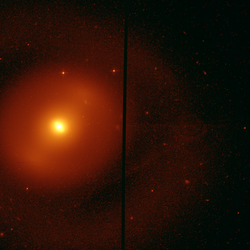Astronomy:NGC 2859
| NGC 2859 | |
|---|---|
 NGC 2859 imaged by the Hubble Space Telescope | |
| Observation data (J2000 epoch) | |
| Constellation | Leo Minor |
| Right ascension | 09h 24m 18.549s[1] |
| Declination | +34° 30′ 48.16″[1] |
| Redshift | 1687 ± 8 km/s[2] |
| Distance | 82.8 Mly (25.4 Mpc)[3] |
| Apparent magnitude (V) | 11.8[2] |
| Characteristics | |
| Type | (R)SB(r)0+[4] |
| Apparent size (V) | 4′.3 × 3′.8[2] |
| Notable features | Double barred |
| Other designations | |
| UGC 5001, PGC 26649[2] | |
NGC 2859 is a barred lenticular galaxy located some 83[3] million light years away in the constellation Leo Minor. The morphological classification is (R)SB(r)0+,[4] where the S0+ notation indicates a well-defined physical structure that is lacking in visible spiral arms. It has a strong bar (B) of the "ansae" type, which means it grows brighter or wider toward the tips. A faint, secondary bar is positioned at nearly a right angle to the main bar. These features are surrounded by a weak inner ring (r) that appears diffuse. The outer region of the galaxy hosts a prominent, detached ring (R) that includes a series of blue-hued knots along the eastern side.[4]
The central supermassive black hole is an estimated 105 million times the mass of the Sun. The nucleus is tentatively classified as a transition type T2:,[3] with no indication of activity.[5]
References
- ↑ Jump up to: 1.0 1.1 Skrutskie, Michael F.; Cutri, Roc M.; Stiening, Rae; Weinberg, Martin D.; Schneider, Stephen E.; Carpenter, John M.; Beichman, Charles A.; Capps, Richard W. et al. (1 February 2006). "The Two Micron All Sky Survey (2MASS)". The Astronomical Journal 131 (2): 1163–1183. doi:10.1086/498708. ISSN 0004-6256. Bibcode: 2006AJ....131.1163S.
- ↑ Jump up to: 2.0 2.1 2.2 2.3 Jet Propulsion Laboratory, California Institute of Technology. "Results for NGC 2859". NASA/IPAC Extragalactic Database. National Aeronautics and Space Administration. http://ned.ipac.caltech.edu/cgi-bin/objsearch?objname=NGC+2859&extend=no&hconst=73&omegam=0.27&omegav=0.73&corr_z=1&out_csys=Equatorial&out_equinox=J2000.0&obj_sort=RA+or+Longitude&of=pre_text&zv_breaker=30000.0&list_limit=5&img_stamp=YES.
- ↑ Jump up to: 3.0 3.1 3.2 Richings, A. J. et al. (August 2011), "The connection between radio loudness and central surface brightness profiles in optically selected low-luminosity active galaxies", Monthly Notices of the Royal Astronomical Society 415 (3): 2158–2172, doi:10.1111/j.1365-2966.2011.18845.x, Bibcode: 2011MNRAS.415.2158R.
- ↑ Jump up to: 4.0 4.1 4.2 Buta, Ronald J.; Corwin, Harold G.; Odewahn, Stephen C. (2007), Atlas of Galaxies, Cambridge University Press, p. 118, ISBN 978-0521820486, https://books.google.com/books?id=g-P7dCbB5MEC&pg=PA116.
- ↑ de Lorenzo-Cáceres, A. et al. (May 2013), "Distinct stellar populations in the inner bars of double-barred galaxies", Monthly Notices of the Royal Astronomical Society 431 (3): 2397–2418, doi:10.1093/mnras/stt334, Bibcode: 2013MNRAS.431.2397D.
External links
- NGC 2859 on WikiSky: DSS2, SDSS, GALEX, IRAS, Hydrogen α, X-Ray, Astrophoto, Sky Map, Articles and images
Coordinates: ![]() 09h 24m 18.549s, +34° 30′ 48.16″
09h 24m 18.549s, +34° 30′ 48.16″
 |

